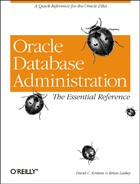Parallel Server Configuration
In order to utilize Oracle Parallel Server (OPS), which allows a single Oracle database to be shared by multiple Oracle instances, you must carefully specify the Parallel Server characteristics using INIT.ORA parameters on each participating instance, including:
- PARALLEL_SERVER
Must be set to TRUE to enable the Oracle Parallel Server (Oracle8 only).
- INSTANCE_NUMBER
Identifies the instance to the database.
- ROLLBACK_SEGMENTS
Specifies the private rollback segments to be used by each instance. Public rollback segments can also be specified, but this is not necessary.
- THREAD
Identifies the redo log thread to be associated with the instance.
- GC_DB_LOCKS
The total number of instance locks (Oracle7 only).
- GC_FILES_TO_LOCKS
The number of database file locks.
- GC_LCK_PROCS
The total number of distributed locks.
- GC_ROLLBACK_LOCKS
The total number of rollback locks.
- GC_SAVE_ROLLBACK_LOCKS
The number of rollback save locks (Oracle7 only).
- GC_SEGMENTS
The maximum number of segments that may have activities impacting space management performed on them simultaneously (Oracle7 only).
- INSTANCE_GROUPS
Assigns the instance to one or more specified groups (Oracle8 only).
- LM_LOCKS
The number of locks that will be configured for the lock manager (Oracle8 only).
- LM_PROCS
The number of processes for the lock manager (Oracle8 only).
- LM_RESS
The number of resources that can be locked by each lock manager instance (Oracle8 only).
- OPS_ADMIN_GROUP
Assigns the instance to a group for monitoring (Oracle8 only).
- PARALLEL_INSTANCE_GROUP
Identifies the parallel instance group to be used for spawning parallel query slaves (Oracle8 only).
- ROW_LOCKING
Should be set to ALWAYS.
- SERIALIZABLE
Should be set to FALSE (Oracle7 only).
- SINGLE_PROCESS
Should be set to FALSE (Oracle7 only).
Additional information on these parameters can be found in Chapter 12. Because Oracle Parallel Server is a very complex product, you should consult the Oracle Parallel Server Concepts and Administration Guide before attempting to configure a Parallel Server environment. Here are a few points to keep in mind when doing this configuration:
On Unix platforms, all datafiles must be created in raw partitions.
When creating a database, only redo thread 1 is created automatically; additional threads must be explicitly created, and you must specify which thread a redo log belongs to.
Although not required, ensuring that the instance number and thread number are the same will avoid confusion.
Tip
The terms “Parallel Query” and “Parallel Server” are often confused. Parallel Query refers to the ability of a single Oracle instance to divide an operation (for example, a full table scan) across multiple CPUs on the same host computer and merge the completed results. Parallel Server, on the other hand, is a feature whereby multiple Oracle instances on different host machines share a single physical database. In this case, work is divided across Oracle instances either by distributing users across multiple instances, or by spawning parallel query processes across instances.
